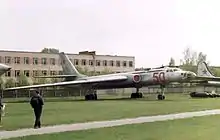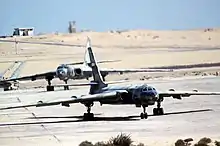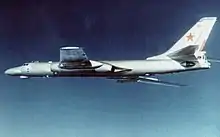| Tu-16 | |
|---|---|
_c1978.jpg.webp) | |
| A Tu-16 in flight over USS Hewitt (circa 1978) | |
| Role | Strategic bomber |
| National origin | Soviet Union |
| Manufacturer | Voronezh Aircraft Production Association[1] |
| Designer | Tupolev |
| First flight | 27 April 1952 |
| Introduction | 1954 |
| Status | In limited service |
| Primary users | Russian Air Force Egyptian Air Force (Historical) Iraqi Air Force (Historical) Indonesian Air Force (Historical) |
| Produced | 1952–1962 |
| Number built | 1,509 |
| Variants | Tupolev Tu-104 Tupolev Tu-124 Xian H-6 |
The Tupolev Tu-16 (USAF/DOD reporting name Type 39;[2] NATO reporting name: Badger)[3] is a twin-engined jet strategic heavy bomber used by the Soviet Union. It has been flown for almost 70 years, and the Chinese license-built version Xian H-6 remains in service with the People's Liberation Army Air Force, with more being built as of 2020.[4]
Development

In the late 1940s, the Soviet Union was strongly committed to matching the United States in strategic bombing capability. The Soviets' only long-range bomber at the time was Tupolev's Tu-4 'Bull', a reverse-engineered copy of the American B-29 Superfortress. The development of the notably powerful Mikulin AM-3 turbojet led to the possibility of a large, jet-powered bomber.
The Tupolev design bureau began work on the Tu-88 ("Aircraft N") prototypes in 1950. The Tu-88 first flew on 27 April 1952. After winning a competition against the Ilyushin Il-46, it was approved for production in December 1952. The first production bombers entered service with Frontal Aviation in 1954, receiving the service designation Tu-16. It received the NATO reporting name Badger-A.

It had a new, large swept wing and two large Mikulin AM-3 turbojets, one in each wing root. It could carry a single massive FAB-9000 9,000 kg (20,000 lb) bomb (the Russian equivalent in terms of size of the British Grand Slam, but a conventional bomb rather than a deep ground penetrator) or various nuclear weapons for a range of around 4,800 km (3,000 mi). Production took place in three aviation plants, Kazan Aircraft Production Association, Kuybyshev, and Voronezh Aircraft Production Association.
Although the Tu-16 began as a high-altitude, free-fall bomber, in the mid-1950s, it was equipped to carry early Soviet cruise missiles. The Tu-16KS-1 (Badger-B) version could carry AS-1 missiles over a combat radius of 1,800 km (1,100 mi). These very large weapons were aerodynamically similar to the Mikoyan-Gurevich MiG-15 fighter, fitted with either a nuclear or conventional warhead, having a range of about 140 km (85 mi). They were intended for use primarily against US Navy aircraft carriers and other large surface ships. Subsequent Tu-16s were converted to carry later, more advanced missiles, while their designations changed several times.

A versatile design, the Tu-16 was built in numerous specialized variants for aerial reconnaissance, maritime surveillance, electronic intelligence gathering (ELINT), and electronic warfare (ECM). In total, 1,507 aircraft were constructed in three plants in the Soviet Union, in 1954–1962. A civilian adaptation, the Tupolev Tu-104, saw passenger service with Aeroflot. The Tu-16 was also exported to Indonesia, Egypt, and Iraq. It continued to be used by the Air Forces and naval aviation of the Soviet Union and subsequently Russia, until 1993.
Delivery of the Tu-16 to China began in 1958, and the Xi'an Aircraft Industrial Corporation license-produced the aircraft under the Chinese designation Xian H-6. At least 120 of these aircraft remain in service. On 14 May 1965, one of the PLAAF Tu-16 bombers carried out the first airborne nuclear weapon test inside China.[5]
Variants
Among the main production variants of the Badger were the Tu-16 and Tu-16A bombers and Tu-16KS and Tu-16K-10 missile carriers, Tu-16SPS, "Elka", and Tu-16Ye ECM aircraft, Tu-16R reconnaissance aircraft, and Tu-16T torpedo bombers; others were produced from conversions. Individual aircraft could be modified several times, with designations changed, especially concerning missile-carrying aircraft.
- "Aircraft 88" - Initial prototype.
- "Aircraft 97" - Twin-engined long-range bomber development project of Tu-16 with two RD-5 engines.
- "Aircraft 103" - Supersonic bomber development project of Tu-16 with four VD-7 AM-13 engines.
- Badger A (Tu-16) – This is the basic configuration of the Tu-16 bomber deployed in 1954 to replace the Tu-4. Several modified models of this variant existed, all of which were known as Badger A in the West.

- Tu-16A – Modified Tu-16s designed to carry nuclear bombs, one of main versions, with 453 built. Many of these were subsequently converted into other variants.
- Tu-16Z – An early specialized version of the Tu-16 that served as airborne tankers (a refuelling method: wing-to-wing), though retaining their medium bomber role.
- Tu-16G (Tu-104G) – Fast air mail model, Aeroflot aircrew training version.
- Tu-16N – A dedicated tanker version for Tu-22/Tu-22M bombers, with probe and drogue system. Entered service in 1963. Similar aircraft Tu-16NN converted from Tu-16Z.
- Tu-16T – Limited production maritime strike version (torpedo bomber), that served in the Soviet Naval Aviation, and carried torpedoes, mines and depth charges. 76 built and some more converted. All units subsequently converted into Tu-16S configuration.
- Tu-16S – A lifeboat carrier version used for search and rescue operations.
- Tu-16Ye – These were equipped with heavy electronic warfare and electronic intelligence (ELINT) equipment.
- Badger B (Tu-16KS) – Variant designed as a launch platform for two AS-1 Kennel/KS-1 Komet missiles. 107 built in 1954–1958, served with the Soviet Naval Aviation, Egypt and Indonesia. Soviet ones later converted with newer missiles.

- Badger C (Tu-16K-10) – Another Naval Aviation variant, units of this version carried a single AS-2 Kipper/K-10S anti-ship missile. 216 built in 1958–1963. It differed from other variants in having a radar in a nose. A further development, the Tu-16K-10-26, carried a single K-10S and two KSR-2 or KSR-5 AS-6 Kingfish missiles (K-26 missile complex). Some were later converted into ELINT platforms.
- Badger D (Tu-16RM-1) – Maritime reconnaissance model with ELINT equipment; 23 converted from Tu-16K-10. It retained its radar in a nose and could guide K-10S missiles, fired from other planes, at targets.
- Badger E (Tu-16R) – Reconnaissance version of the airframe, with ELINT equipment, first of all meant for maritime reconnaissance. It could guide KS missiles.
- Tu-16RM-2 – modified Tu-16R, serving in the Naval Aviation. It could guide KSR-2 missiles.
- Tu-16KRM – Launch platforms for target drones (a variant of Tu-16K-26).
- Badger F (Tu-16RM-2) – Another reconnaissance version based on the −16R/RM but with the addition of external ELINT equipment.

- Badger G (Tu-16K/Tu-16KSR) – Serving in the Naval Aviation, these were conversions from earlier models. These were designed to carry bombs in internal bays in addition to carrying air-to-surface missiles externally, such as the AS-5 Kelt and AS-6 Kingfish. There existed numerous variants, designated either from carried missile complex (K-11, K-16 and K-26) or from missiles of these complexes (KSR-11, KSR-2 and KSR-5). Following further modifications, they were also given suffixes. Main variants:
- Tu-16KSR-2 – carrying the K-16 complex (two KSR-2 missiles). Used from 1962. Similar aircraft, converted from other variants, were designated Tu-16K-16.
- Tu-16K-11-16 – carrying the K-16 complex (KSR-2 missiles) or the K-11 complex (two anti-radar KSR-11 missiles). Used from 1962. Similar aircraft were designated Tu-16KSR-2-11. Over 440 Tu-16 could carry the K-16 or K-11 complex.

- Tu-16K-26 – carrying the K-26 complex (two KSR-5 missiles), retaining a capability of KSR-2 and 11 missiles. Used from 1969. Similar aircraft were designated Tu-16KSR-2-5-11 or Tu-16KSR-2-5 (no KSR-11 capability). Over 240 Tu-16 could carry the K-26 complex.
- Tu-16K-26P – carrying the K-26P missiles (two anti-radar KSR-5P missiles, as well as KSR-5, 2 or 11).
- Badger H (Tu-16 Elka) – Designed for stand-off electronic warfare and electronic counter-measures support.
- Badger J (Tu-16P Buket) – Another electronic warfare variant configured as an ECM strike escort.
- Badger K (Tu-16Ye) – Believed to be a version of the Badger F configuration possessing enhanced ELINT capability.
- Badger L (Tu-16P) – Another version of the Badger J with more modern systems and used in ELINT role.
- "Aircraft 90" - Turboprop-powered project.
- Tu-104 - Civilian airliner version.
Former operators

- Armenian Air Force: 30 aircraft inherited from the Soviet Union. Out of service by 1995.[6]
- Azerbaijan Air Force: 10 aircraft inherited from the Soviet Union. Out of service by 1995.[7]
- Belarus Air Force: 18 aircraft inherited upon the fall of the Soviet Union,[8] out of service by 1995.[9]
- People's Liberation Army Air Force: A few Tu-16s were acquired in 1959; the type was then built under licence as the Xian H-6.
- Egyptian Air Force: Operated Tu-16KS, Tu-16T, Tu-16KSR-2-11, and Tu-16R. Also operated H-6. Last retired in 2000.[10] By 1966, Air Group 65, with its primary base at Cairo West Air Base, was operating three squadrons of Tu-16s: No. 34 and 36 Squadrons with bomber variants, and No. 95 Squadron equipped with the Tu-16KS' that could carry AS-1 Kennel air-to-surface missiles.[11]
- Georgian Air Force: 20 aircraft inherited from the Soviet Union. Out of service by 1995.[12]

- Indonesian Air Force (TNI-AU): 26 Tu-16KS-1 acquired in 1961. Used during the preparation of Operation Trikora in 1962, being the capture of Western New Guinea from the Netherlands (now Papua and Papua Barat). They were also planned to be used for attacking the Colossus-class aircraft carrier HNLMS Karel Doorman. All were based at Iswahjudi Air Force Base, Madiun, East Java, and were grounded in 1969. Removed from service in 1970.[10]
- Iraqi Air Force: 8 x Tu-16 and 6 x Tu-16KSR-2-11. Also operated 4 B-6D (H-6D). One B-6D was downed during the Iran-Iraq War. Two were destroyed in Operation Desert Storm in 1991.[10]
- Soviet Air Force (transferred to successor states)
- Soviet Naval Aviation (transferred to successor states)
- Ukrainian Air Force: 121 aircraft inherited from USSR.[8] All retired from service.
Notable accidents
- On 25 May 1968 a Soviet Air Force Tu-16 Badger-F piloted by Colonel Andrey Pliyev buzzed the US Navy aircraft carrier USS Essex (CV-9) in the Norwegian Sea.[13] The Tu-16 made four passes, and on the last a wing clipped the sea and it crashed with no survivors. Parts of three bodies were recovered by the US.[14][15][16]
- On 1 February 1971 a modified Tu-16 flying laboratory crashed during testing of a new jet engine, resulting in the death of the entire crew, including test pilot Amet-khan Sultan.[17]
- On 28 August 1978 an early model Tu-16 crashed on Hopen island in Svalbard, Norway. All seven crew were killed in the accident. It was discovered by a four-man Norwegian weather forecasting team. The Soviets refused to admit the loss of an aircraft until the bodies of the crew were given to them. Norway transcribed the contents of the flight recorder over the objections of the Soviet government.[18][19][20]
- On 27 June 1980 a Soviet Air Force Tu-16 Badger on a Tokyo Express flight crashed near Komatsu Air Base in Ishikawa Prefecture in the Sea of Japan. There were no survivors. The remains of three crew members were recovered by the Japanese Maritime Self-Defense Force ship Nemuro.
Specifications (Tu-16)

General characteristics
- Crew: 6-7
- Length: 34.80 m (114 ft 2 in)
- Wingspan: 33.00 m (108 ft 3 in)
- Height: 10.36 m (34 ft 0 in)
- Wing area: 165 m2 (1,780 sq ft)
- Empty weight: 37,200 kg (82,012 lb)
- Gross weight: 76,000 kg (167,551 lb)
- Max takeoff weight: 79,000 kg (174,165 lb)
- Powerplant: 2 × Mikulin AM-3 M-500 turbojets, 93.2 kN (21,000 lbf) thrust each
Performance
- Maximum speed: 1,050 km/h (650 mph, 570 kn)
- Range: 7,200 km (4,500 mi, 3,900 nmi)
- Service ceiling: 12,800 m (42,000 ft)
- Wing loading: 460 kg/m2 (94 lb/sq ft)
- Thrust/weight: 0.24
Armament
- Guns: 6–7 × 23 mm Afanasev Makarov AM-23 cannons, two each in dorsal and ventral remote turrets and manned tail turret, with the occasional addition of one fixed forward in the nose
- Hardpoints: 2 Underwing hardpoints for missiles and a bomb bay for missiles or bombs (depending on variant)
- Missiles:
- Badger-B 2 × Raduga KS-1 Komet (AS-1 Kennel) anti-ship missile on underwing hardpoints
- Badger-C 1 × Raduga K-10S (AS-2 Kipper) anti-ship missile semi-recessed in bomb bay
- Badger-C/G 2 × Raduga KSR-2 (AS-5 Kelt) or Raduga KSR-5 (AS-6 Kingfish) anti-ship missile on underwing hardpoints
- Bombs: Badger-A + Export versions 9,000 kg (20,000 lb) of free-fall weapons
See also
Related development
Aircraft of comparable role, configuration, and era
References
Footnotes
- ↑ "Предприятие". www.vaso.ru. Archived from the original on 6 May 2018. Retrieved 6 May 2018.
- ↑ Jane's All the World's Aircraft p. 188
- ↑ "Designations of Soviet and Russian Military Aircraft and Missiles". www.designation-systems.net. Archived from the original on 11 October 2017. Retrieved 6 May 2018.
- ↑ Axe, David (16 November 2020). "The Chinese Air Force Sure Is Buying A Lot Of Bombers". Forbes.
- ↑ "Tu-16 bomber carried out nuclear bomb test in China, 1965". AirForceWorld.com. Archived from the original on 6 September 2011. Retrieved 15 July 2011.
- ↑ "World Air Forces". Armenia Air Force. Archived from the original on 2007-01-15. Retrieved 2007-01-12.
- ↑ "World Air Forces". Azerbaijan Air Force. Archived from the original on 2006-11-12. Retrieved 2007-01-12.
- 1 2 "Aircraft Profile:Tupolev Tu-16 Badger". Air International. August 2006.
- ↑ "World Air Forces". Belarus Air Force. Archived from the original on 2006-12-31. Retrieved 2007-01-12.
- 1 2 3 "VectorSite". The Tupolev Tu-16 "Badger". Archived from the original on 2012-04-17. Retrieved 2007-01-12.
- ↑ Cooper, Tom (18 April 2020). "Did you know the former President of Egypt Hosni Mubarak was a good military pilot? Part 2 Nocturnal Il-28 reconnaissance sorties over Israe". AviationGeekClub.com. Retrieved 19 April 2020.
- ↑ "World Air Forces". Georgia Air Force. Archived from the original on 2007-01-17. Retrieved 2007-01-12.
- ↑ Cenciotti, David (14 April 2016). "That time a Soviet bomber crashed into the sea after buzzing a U.S. aircraft carrier". The Aviationist. Archived from the original on 14 August 2017.
- ↑ "Russ bomber falls in sea near U.S. ship May 26, 1968" Archived August 14, 2017, at the Wayback Machine Chicago Tribune Retrieved August 14, 2017
- ↑ The Games Pilots Play Over the Mediterranean August 23, 1981 Archived August 28, 2017, at the Wayback Machine New York Times Retrieved August 14, 2017
- ↑ ASN Aircraft Accident 27-May-1968 Tupolev Tu-16 Badger Archived 2017-08-14 at the Wayback Machine Aviation Safety Network Retrieved August 14, 2017
- ↑ Simonov, Andrey; Bodrikhin, Nikolai (2017). Боевые лётчики — дважды и трижды Герои Советского Союза [Combat pilots - Twice and thrice Heroes of the Soviet Union]. Moscow: Russian Knights Foundation and Vadim Zadorozhny Museum of Technology. p. 46. ISBN 9785990960510. OCLC 1005741956.
- ↑ Soviet Union Military Plane Crashes in Norway October 27, 1978 Archived May 6, 2018, at the Wayback Machine Retrieved August 15, 2017
- ↑ Svalbard Arctic out post at strategic crossroads September 9, 1980 Archived August 15, 2017, at the Wayback Machine Christian Science Monitor Retrieved August 15, 2017
- ↑ Umbreit, Andreas Bradt Svalbard: Spitzbergen with Frank Josef Land & Jan Mayen page 132 Retrieved August 15, 2017
Bibliography
- Healey, John K. (January–February 2004). "Retired Warriors: 'Cold War' Bomber Legacy". Air Enthusiast. No. 109. pp. 75–79. ISSN 0143-5450.
- "Pentagon Over the Islands: The Thirty-Year History of Indonesian Military Aviation". Air Enthusiast Quarterly (2): 154–162. n.d. ISSN 0143-5450.
- Russian Strategic Nuclear Forces,edited by Pavel Podvig, The MIT Press, 2001.
- Soviet Military Power: 1983, 1984, 1986, 1987, 1988
- Ту-16. Ракетно-бомбовый ударный комплекс Советских ВВС, Voyna v Vozduhye series no 26
- EDISI KOLEKSI ANGKASA, RUDAL UDARA TRACKED AND DESTROYED, Edition of September 2006.
External links
- FAS on the Tu-16
- Xian H-6 Badger
- H-6 Medium Bomber
- http://airwar.ru/ – Ugolok Neba (Russian language)
- H-6H and H-6K Cruise Missile Bomber, AirForceWorld.com